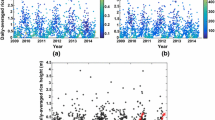Abstract
One approach that may help elucidate certain mechanisms of biological sensing is based on a concept developed by engineers in the 1940’s. Operations research seeks to describe the black box or functional behavior of a complex system without determining its exact relationship to the myriad behaviors and interactions of its many components. For example, using this perspective, it may be possible to identify the physical basis underlying sensory capability before identifying the biological pathway by which the sensing occurs at the cellular level. To illustrate this idea, the present Chapter describes a physical process, which provides filtered information that might allow the members of a plant community to monitor the effects of their collective wind-induced motion. Specifically, the energetics of crop canopy ventilation are studied for a wheat crop excited by a non-steady flow. In the model, the wind gust elicits large scale motions facilitating waste gas clearance out of the canopy and into the overlying airspace. As described below, the volumetric flow per unit time is found to be independent of gust velocity but varies in inverse proportion to stalk flexural stiffness. If waste gas clearance represents an important evolutionary constraint, healthy canopy plants may indeed sense intracanopy gas concentration and modulate their biomechanical properties accordingly.
Access this chapter
Tax calculation will be finalised at checkout
Purchases are for personal use only
Preview
Unable to display preview. Download preview PDF.
Similar content being viewed by others
References
Barlow PW (1995) Gravity perception in plants: a multiplicity of systems derived by evolution? Plant Cell Environment 18: 951–962
Biddington NL (1986) The effects of mechanically-induced stress in plants, a review. Plant Growth Regulation 4: 103–123
Brunet Y, Finnigan JJ, Raupach M (1995) A wind tunnel study of air flow in waving wheat: single point statistics. Bound Layer Meteo 70: 95–132
Bugbee B, Salisbury FB (1988) Exploring the limits of crop productivity. Plant Physiol 88: 869–878
Evans LT, Fischer RA (1999) Yield potential: its definition, measurement, and significance. Crop Science 39: 1544–1551
Farquhar T, Meyer H, van Beem J (2000 a) Effect of aeroelasticity on the aerodynamics of wheat. Matls Scien Engr C 7: 111–117
Farquhar T, Wood JZ, van Beem J (2000 b) The kinematics of wheat struck by a wind gust. J Applied Mechanics 67: 496–502
Farquhar T, Meyer-Phillips H (2001) Relative safety factors against global buckling, anchorage rotation, and tissue rupture in wheat. J Theoretical Biology 211: 55–65
Farquhar T, Zhou J (2002) Competing effects of buckling and anchorage strength on optimal wheat stem geometry. J Biomech Engr (in press)
Farquhar T, Zhou J, Meyer H (2002) Rhtl dwarfing gene selectively decreases the material stiffness of wheat. J Biomech (in press)
Finnigan JJ (1979) Turbulence in waving wheat. Mean statistics and Honami. Bound Layer Meteo 16: 181–236
Fischer RA, Stapper M (1987) Lodging effects on high-yielding crops of irrigated semidwarf wheat. Field Crops Research 17: 245–258
Fritig B, Legrand M (1993) Mechanisms of plant defense responses. Kluwer Acad Publ. Boston MA
Gent MPN, Kiyomoto RK (1998) Physiological and agronomic consequences of Rht genes in wheat. In: Amarjit S. Basra (ed) Crop Science: Recent Advances. Hawthorne Press. Binghampton NY
Inoue E (1955) Studies of the phenomenon of waving plants (Honami) caused by wind. J Agric Meteo (Japan) 11: 18–22
Jaffe MJ, Forbes S (1993) Thigmomorphogenesis: the effect of mechanical perturbation on plants. Plant Growth Regulation 12: 313–324
Mitchell C (1996) Recent advances in plant response to mechanical stress. HortScien 31: 31–35
Shaw RH (1985) Gust penetration into plant canopies. Atmos Envir 5: 827–830
Speck T, Spatz HC, Vogellehner D (1990) Capabilities of plant stems with strengthening elements of different cross-sections against weight and wind forces. Botanica Acta, 103: 111–122
Zebrowski J (1999) Dynamic behavior of inflorescence bearing triticale and triticum stems. Planta 207: 410–417
Editor information
Editors and Affiliations
Rights and permissions
Copyright information
© 2003 Springer-Verlag Wien
About this chapter
Cite this chapter
Farquhar, T., Zhou, J., Haslach, H.W. (2003). A Possible Mechanism for Sensing Crop Canopy Ventilation. In: Barth, F.G., Humphrey, J.A.C., Secomb, T.W. (eds) Sensors and Sensing in Biology and Engineering. Springer, Vienna. https://doi.org/10.1007/978-3-7091-6025-1_15
Download citation
DOI: https://doi.org/10.1007/978-3-7091-6025-1_15
Publisher Name: Springer, Vienna
Print ISBN: 978-3-7091-7287-2
Online ISBN: 978-3-7091-6025-1
eBook Packages: Springer Book Archive




